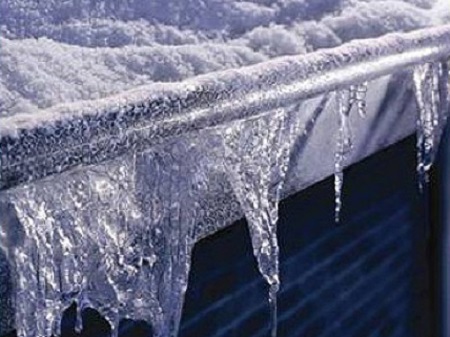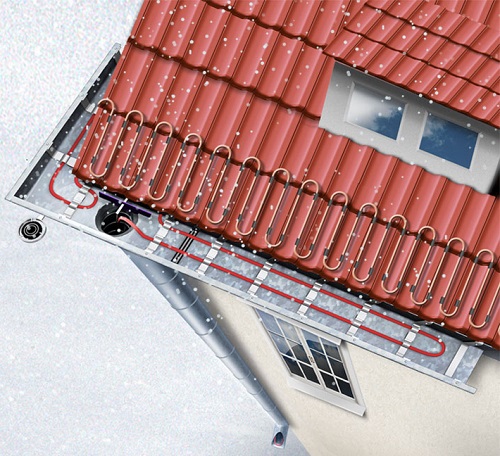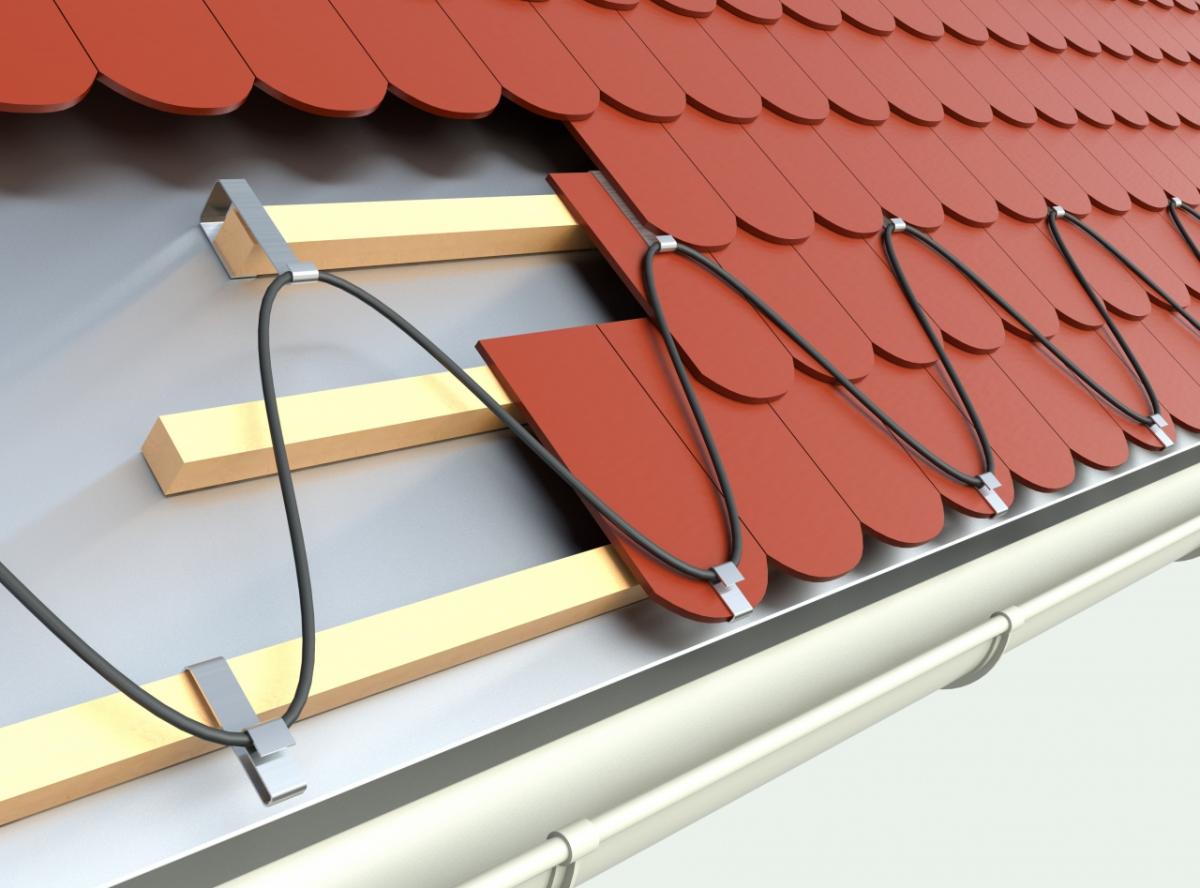The climatic conditions on the territory of our country are such that during cold weather the temperature drops below 0 C, and this leads to the formation of ice on roads, sidewalks and roofs. The latter is a particular problem, since not every design allows you to quickly remove it. The best solution is heating the roof. What is the danger of frost is easiest to show with examples:
- Damage to various designs. If you do not use any heating systems, you can be sure that soon you will need to repair the gutters, which on the pitched roof will be easily damaged by the sliding masses of icy and compressed snow.
- Icicle formation. Chunks of ice hanging over the heads of passers-by is another problem, since even dense clothes will not protect against getting such a shell, not to mention the usual hat. Everything is complicated by the fact that cable systems for heating the roof are still not widespread, so the various outbuildings or visors located on the ground floors also suffer, because the mass of ice can reach several kilograms.
- Leaks. Accumulated ice is water that will begin to collect on the roof during the thaw. If we are talking about a rolled roof, then even the slightest damage will be expensive for moisture, which means that more serious problems will soon appear.
- Decrease in a resource of a design. Of course, for residential buildings in the city this problem is irrelevant, however, suburban low-rise buildings will not always be able to transfer a large amount of snow accumulated on the roof. Regardless of the reasons that led to a similar situation, the result will be one - damage to the coating or even the elements of the crate, which will not withstand the mass of snow. Heating the roof will avoid such difficulties.
In fact, the snow load, which is calculated for each specific region, can be exceeded several times, since the ice is quite dense, and it accumulates throughout the winter. To avoid the problems described above, it is only necessary to exclude only two factors contributing to the formation of ice that appears when roof heating is not installed.
Content
Causes of frost

The first of them is the temperature difference, which arises due to the characteristics of the climate or warmer air in the city. If during the day the air warms up to positive temperatures, then the ice accumulated on the roofs of the houses grows due to thawing of snow caps. Water immediately begins to freeze, so it does not have time to leave the roof. If roof heating is not used, then gutters that are in the shade or already filled with ice plugs do not allow moisture to be removed, so by the beginning of the night more ice will form on the roof than it was at the beginning of the day. Gradually, more and more water goes into ice, and then the process takes on an avalanche-like character. The result is the appearance of a thick crust of ice, which has a fairly substantial mass, and removing it is not always easy.

The problem with ice is also caused by the fact that only cable heating of the roof is a reliable protection. The method that is still used for crushing compressed snow and ice on the sidewalks is not suitable here.In winter, the roll cover becomes brittle, and it is very easy to damage it, so they try to remove snow before it starts to thaw, which is not always possible to do during heavy snowfalls.
The second problem is the heating of the roof with heat that seeps through improperly made insulation. The temperature difference leads to the formation of water and then ice, which quickly begins to accumulate where the heat does not reach. The root of the problem is that the insulation must be installed correctly, since it not only protects the building from heat loss through the roof, but also is a guarantee against ice formation.
Video about the device system Teploskat
Why do we need roof heating
The main task that this type of system solves is that ice forms should not form on the roof surface. The most effective method is to allow meltwater to flow down the drain. Of course, someone may think that the ideal option is to completely remove the snow, but this is not entirely true, since the snow itself does not pose any danger.

You can implement a system that allows you to make the heating of the roof powerful enough to remove snow, but it will consume so much electricity that during the winter, paying the bills will be almost the cost of re-creating the roof. If you are concerned about the problem of snow accumulation, it is best to study materials on the construction of pitched roofs. In our articles, we have already touched on the removal of snow under the influence of its weight and even cited ranges of inclination angles suitable for different materials.
Installation of roof heating is carried out in order to remove icicles and ice from the roofs, but, paradoxically, the system itself does not heat the ice, because it simply does not allow it to form. This solution was made possible through the use of a special cable and the proper placement of heating elements.
The cable itself is laid so that it passes along the path of water. This allows you to provide a positive temperature of the liquid, and therefore, prevents its transition to the solid phase. The most critical places include valleys, dormers, gutters, drains, funnels, pipes and droppers. It is here that the heating of the roof is required.
Pipes are as important part of the whole system as the cable laid on the roof, because without them it will be impossible to remove water, and icicles, on the contrary, will grow very quickly. The simplest option is that a heating cable that performs heating of the roof is also mounted inside the pipes.
The use of the entire system is advisable in the temperature range from +2 to -5 С. At lower temperatures, snow and ice melting on the roof does not occur or it is so slow that it can be neglected.

When we say that thawing does not occur, we mean the conditions in which the insulation is of high quality and correctly laid. Otherwise, even in cold weather, part of the heat that seeps out of the living quarters will heat the roof, which means that ice will appear.
Teploskat roof heating
Today, experts prefer to use integrated solutions that can achieve impressive results with minimal material costs. The Teploskat system represents one of such varieties, which implies the prevention of ice accumulation in drainpipes, along the roof slope and in gutters, where it most often appears. The benefits of using this technology are obvious:
- increase the service life of the roofing and gutters;
- roof heating helps prevent the destruction of building facades;
- the ability to install on the roof of any type;
- no summertime dismantling required.

The main working element of this system is heating cables laid in problem areas, but there are other components that we will discuss below.
First of all, it is worth saying about the cables themselves, the production technology of which eliminates the occurrence of overheating. Even if the heating of the roof is covered with leaves or garbage, its effectiveness will decrease slightly. The cable can be of any length, so it is suitable for installation even on complex structures crowning suburban cottages.
The second element of the system is automation, which includes its own weather station. There are sensors of precipitation, temperature and water availability, and the heart is a microprocessor that analyzes the incoming information and, if necessary, turns on the heating of the roof.
The electricity distribution system is the third element used in the Teploskat technology. It meets all the requirements of the PUE and contains power and signal wires, as well as junction boxes and other elements. All connections are made so that they are inconspicuous, but without compromising accessibility, since even very reliable equipment requires maintenance, and sometimes repair.
Cable roof heating is a reliable technology that is used today for a wide variety of roofs. Of particular interest are buildings of the old construction, since they often have a rebated roof, which suffers greatly from the abundance of ice.
Installation of a heating system
Similar work is carried out by specialists. This point is very important, because with independent wiring, you can not take into account many of the nuances, which, in turn, will cause problems with the roof or its repair. Professionals also work on a finished project, or develop their own. In the first case, all calculations are performed by the customer, but most often they prefer to trust specialists.
Roof heating can be created for new buildings, and for those that require reconstruction. For example, a system is often installed after a major overhaul of a building’s roof. As mentioned above, special attention is paid to problem areas: valleys, drains, pipes and droppers. It is the latter that have a lower temperature than the structure, so if you do not use roof heating, then the icicles begin to grow.
In the article, we described only common features characteristic of various systems and gave an example of the technology used today. Depending on the specific conditions, it can be changed in any direction so that the heating of the roof is most effective.





Alas, no comments yet. Be the first!